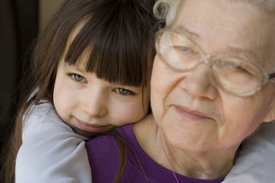Although the symptoms of osteoporosis show up later in life, early adolescence is the best time to prevent the disease

May is National Osteoporosis Awareness and Prevention Month. You might think you know all about osteoporosis, a disease characterized by low bone mass, fragile bones, and high risk for bone fracture, but what you don’t know might surprise you.
For example, did you know...that osteoporosis is a major public health threat for 44 million Americans, 68 percent of whom are women? Or that osteoporosis is responsible for more than 1.5 million bone fractures every year?
What’s more, did you know...that osteoporosis can strike at any age? It’s true. Even though most people think osteoporosis is a disease limited to older people, it can actually affect people of any age. Often it takes until middle age for the symptoms—such as fragile bones and multiple bone fractures—to appear, but the disease itself actually takes hold much earlier in life.
Did you know...that the best time to take action to prevent osteoporosis is during early adolescence?
That’s right. Making sure young people ages 11 to 15 get 1,300 milligrams of calcium—the recommended amount—each day is one of the best ways to help prevent osteoporosis later in life.
The body’s calcium needs are highest during the pre-teen and teen years because they are not only a time of peak skeletal growth, but also a time when the body accumulates more than one-quarter of its adult bone mass. By the time teens' normal growth spurt is finished—usually around age 17—90 percent of their adult bone mass is established. If the body doesn’t get enough calcium during that time, the bones can’t build a healthy bone mass and the risk for osteoporosis and other bone health problems later in life is greatly increased.
Studies show that fewer than one in 10 girls and only one in four boys ages 9 to 13 receive adequate or above-adequate levels of calcium, meaning many young people are putting the lifelong health of their bones at risk.
The NICHD—through its Milk Matters campaign—joins other organizations, including the National Osteoporosis Foundation and the American Academy of Orthopaedic Surgeons, in celebrating National Osteoporosis Awareness and Prevention Month and in helping people of all ages enjoy a lifetime of healthy bones.
Research shows that low-fat or fat-free milk is one of the best sources of calcium because:
- Milk has a high calcium content in a form the body can easily absorb.
- Milk contains other nutrients—including vitamin D, vitamin A, vitamin K, riboflavin, B12, potassium, magnesium, and protein—that are essential to healthy bone and tooth development.
- Milk is widely available and is already a part of many people’s diets.
But milk isn’t the only way to get calcium. Other great sources of calcium include:
- Low-fat and fat-free dairy products—such as cheese and yogurt
- Calcium-fortified items—such as orange juice, bread, and soy beverages
- Dark green, leafy vegetables—such as broccoli, spinach, and bok choy
- Calcium supplements—including drops and chews
Bones also need weight-bearing physical activity—walking, running, jumping rope, and playing team sports such as basketball—to become strong and healthy.
The Milk Matters Web site offers a variety of free materials for parents, health care providers, and teachers that explain the importance of calcium in the diets of young people and provide easy ideas for getting more calcium into the diet every day. Many of these materials are available in both English and Spanish.
This month, the NICHD and other organizations encourage you to get enough calcium and to do weight-bearing physical activity to build healthy, strong bones that last a lifetime.
For more information, check out the following resources:
- Milk Matters Web Site
- All Milk Matters Publications and Materials
- National Osteoporosis Foundation: Healthy Bones, Build Them for Life®

- American Academy of Orthopaedic Surgeons: Early Prevention of Osteoporosis

Originally Posted: May 20, 2010

 BACK TO TOP
BACK TO TOP